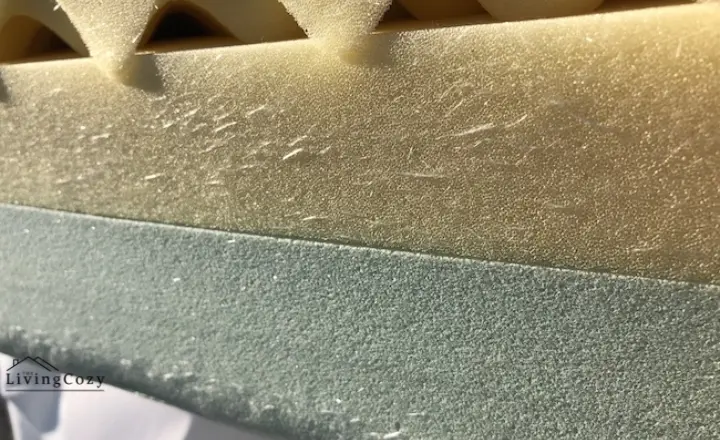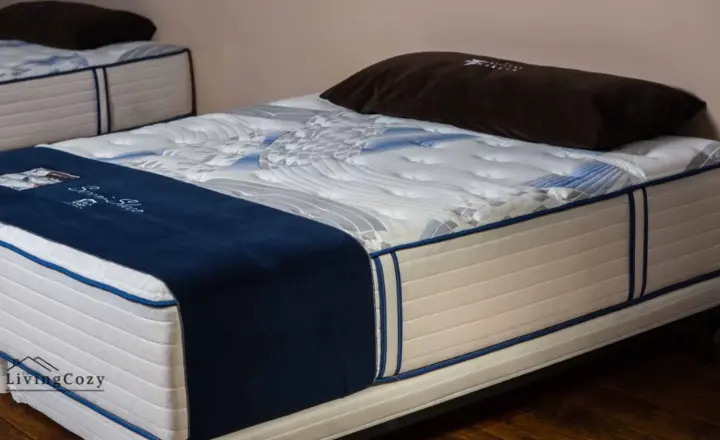You should buy a mattress without fiberglass because it can pose a health risk if the fibers become airborne and are inhaled. Fiberglass particles can irritate the skin, eyes, and respiratory system, leading to discomfort and potential health issues.
Opting for a mattress without fiberglass can help ensure a safer sleeping environment for you and your family. I am giving all the information about buying a mattress without fiberglass.
What is Fiberglass?

Fiberglass is a material made of plastic reinforced with glass fibers. It is commonly used in mattresses as a flame-retardant material to meet safety regulations.
While it is affordable and offers flame-retardant properties, there are potential health risks associated with fiberglass that may not make it safe for sleepers.
Fiberglass is a fiber-reinforced plastic material often used in mattresses for its affordability and flame-retardant properties. Its potential health risks may raise concerns for some sleepers.
Why Is Fiberglass Used in Mattresses?
Fiberglass is used in mattresses primarily for fire safety compliance with US regulations. Mattresses are required to withstand open flames for at least 30 minutes, and fiberglass acts as a flame retardant to meet these safety standards.
Without a flame retardant like fiberglass, mattresses can be highly flammable, posing a significant risk to consumers. The US CPSC estimates these regulations save hundreds of lives yearly, highlighting the importance of using fiberglass as a fire retardant in mattresses.
Fiberglass is utilized in mattresses to ensure they meet fire safety standards set by US regulations.
By acting as a flame retardant, fiberglass helps mattresses withstand open flames for an extended period, reducing the risk of fires and ultimately saving lives. Ensuring mattress safety and compliance with fire safety regulations is essential.
Is Fiberglass Harmful or Dangerous?
Fiberglass in mattresses can pose potential health risks if the material is improperly contained. Long-term exposure to loose fiberglass particles can lead to respiratory issues and lung disease, particularly if the fibers become airborne and are inhaled. Direct skin contact with fiberglass can cause irritation and discomfort.
It’s important to carefully consider the construction of a mattress and ensure that any fiberglass components are securely enclosed within protective layers to minimize the risk of exposure.
Opting for products certified as safe and non-toxic by reputable organizations is advisable when purchasing a mattress. Regularly inspecting and maintaining your mattress can help prevent any potential release of fiberglass particles.
How To Choose Mattresses Without Fiberglass?
It’s important to carefully read product descriptions and manufacturer FAQ pages to ensure the absence of this material. Look for specific language or labels indicating that the mattress is fiberglass-free.
If this information is not readily available, consider reaching out to the company directly through their website to inquire about the flame retardation materials used in their mattresses. Many online mattress brands are responsive to customer inquiries and can provide detailed information about the composition of their products.
To check for fiberglass-free options, you may also want to consider mattresses made with natural or organic materials such as organic cotton, wool, or latex, which can offer a chemical-free and hypoallergenic sleep surface.
By doing thorough research and reaching out to manufacturers for clarification, you can make an informed decision when choosing a mattress that aligns with your preferences and needs.
Mattress Certifications:
It’s important to look for reputable and recognized certifications to ensure the quality and safety of the product. Some of the most common and respected certifications in the industry include:
- CertiPUR-US: This certification ensures that the mattress foam is made without harmful chemicals such as ozone depleters, heavy metals, and formaldehyde. It also evaluates the emissions and durability of the foam.
- GREENGUARD: This certification focuses on indoor air quality and ensures that the mattress meets strict chemical emissions limits, contributing to a healthier indoor environment.
- Global Organic Textile Standard (GOTS): GOTS certification guarantees that the materials used in the mattress are organic, from the farming stage to the finished product, ensuring environmental and social responsibility.
- Global Organic Latex Standard (GOLS): GOLS certification is specific to latex mattresses and verifies that the latex used is organic, ensuring sustainable and environmentally friendly production practices.
These certifications assure consumers about their mattress choices’ safety, quality, and environmental impact.
Final Words:
Choosing a mattress without fiberglass is a wise decision for your and your family’s health and safety. By opting for a fiberglass-free mattress, you can reduce the risk of exposure to harmful particles that may cause skin irritation or respiratory issues.
Such mattresses are more environmentally friendly, as they minimize the release of potentially hazardous substances into the environment. Investing in a fiberglass-free mattress prioritizes your well-being and contributes to a sustainable future.
FAQ’s:
What mattress does not have Fiberglass?
Natural, eco-friendly, and organic mattresses are the best options to avoid fiberglass. These mattresses typically use natural materials such as organic cotton, wool, latex, or bamboo, which do not contain fiberglass.
Can a sectional couch be Fiberglass Free?
No sectional couch was not fiberglass free.


